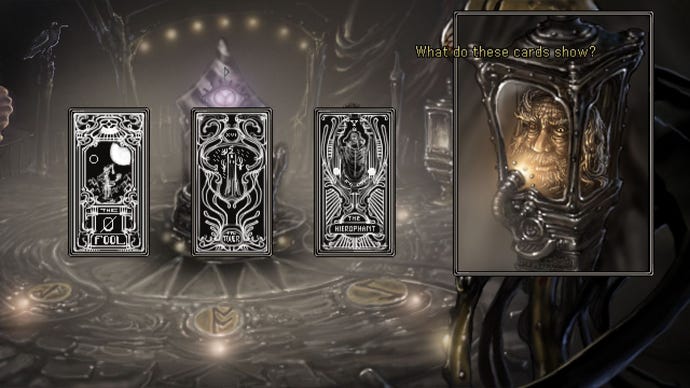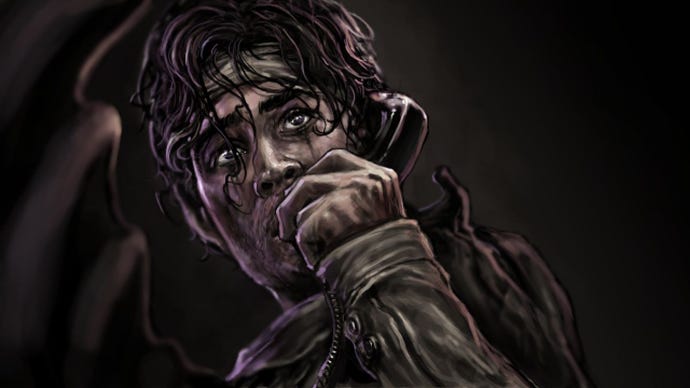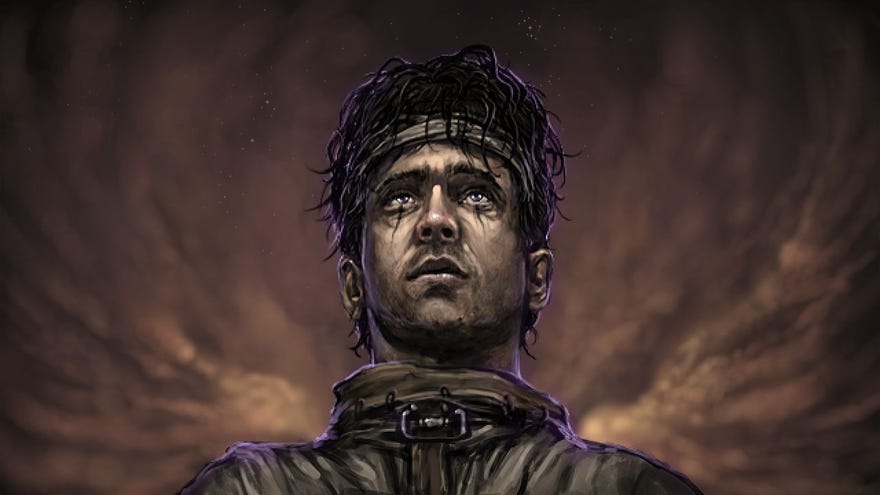Strangeland review: a smart, dark puzzle game that's a bit Marmite-y
Rage, rage against the dying of the light
In Strangeland you, a man in a half-undone, old-timey straightjacket, wake up with no memory of who, what or where you are. The "where", it soon appears, is the titular land, a sort of grimdark carnival floating in a terrible void. It is rendered in lovely pixels that make everything look fleshy, even if the colours are all muted. As soon as you arrive, you see a woman throw herself down a well inside the welcome tent.
It is explained to you - by a raven, a head-in-a-box fortune teller, and a payphone caller who hates you - that she does this repeatedly, because death doesn't work the same here. You immediately fixate on saving this woman, and set about doing so in a point 'n' click puzzle fashion. And if you've seen any prestige horror films in the last few years, or even just engaged with any horror tropes before, you'll figure out what Strangeland's deal is in about 30 seconds.
Its whole vibe is like an episode of Twilight Zone via an episode of American Horror Story via if Tim Burton got trapped in a secret vore nightmare, and every second inhabitant tells the protagonist he's an idiot loser who makes everything he touches worse. Many conversations and visual metaphors end up being about the self, and self-image, and how to change oneself. Eyes and mirrors both come up a lot. There are several references to a black dog. Need I elaborate further?
I'm not smart enough to talk about all the nuances of these kinds of representations; I don't know, for example, if anything in Strangeland is particularly crass or offensive. But the reason that horror keeps going back to the trauma-and-depression-metaphor well is that it is an enduringly effective way to make an audience feel uncomfortable. Not that Strangeland is going to keep you up at night, but it's got some cool, graphic - or at least graphically weird - bits that take advantage of its form. It's a bit of a wincer to see a woman's head slowly sliding into a cross section of two pieces as she says "help me!", even if it's all in greyscale pixels. As a work of horror Strangeland is doing way more interesting things than yer Outlasts, for example.
"As a work of horror Strangeland is doing way more interesting things than yer Outlasts."
It's also pretty funny at times. Throwing stones at a raven that has your face just kind of is, as are several of the characters. My favourite is a big furnace called Eight-Three (as in 8-3), who feels a bit like one of the robots from Futurama. Eight-Three is grand and monotone but also still really can't be arsed with you. When you say goodbye to them, they go "YOU HAVE SAID SO BEFORE" in a way that communicates a raised eyebrow without any eyebrows in sight.
Some of the rest of it feels a bit like it's trying too hard to be clever, with banterous wordplay becoming a bit strained, and metaphors and edginess crashing into a mix of mythical references that would have made me roll my eyes. Get a load of this guy dot jaypeg. But at several points other characters have a go at the protagonist for, essentially, being a naval-gazing hack because of this very thing. A risky move, but I'll allow it.
I have a feeling the tone of Strangeland is the Marmite bit, predicted by how strong your reaction is to the kind of sad short stories about bad relationships or depression that have spiders or clowns doodled in the margins. But the other bit is the puzzle bit, which is unambiguously good. Expect the usual picking up of things and combining them in your inventory, or using them on the envrionment. Except because of the setting it's all stuff like "rat skin" and "homunculus".

Point and click adventure games have largely moved away from the old 'use random thing on other thing for inexplicable reason' kind of puzzle solution. Even so, Strangeland is smarter than most, and lays out puzzles and solutions so you can see the path before you gradually lighting up. Sometimes you might see a lamp flicker on a few steps down the road, and it's very pleasing when the gaps get filled in. Gold wings are made mention of, but you don't find anything gold for a while after that, and even then you need to figure out how to sharpen your knife - which you know involves finding out a mermaid's name... Much like Hannibal, I love it when a plan comes together.
There are other little touches that I really appreciate. You can use a mouse wheel to scroll through and select the items in your inventory, for example, and you can use the in-game payphone to call a tip line that has specific and useful advice. Rather than saying "you need to light the spirit lamps", which you already knew, Strangeland will tell you exactly how to do that, or note that you have eveything you need in you inventory already. The voice on the end of the line is exasperated at your calls for help, too.

Strangeland is careful to say that though some puzzles have more than one solution, and you may make some choices, there is no bad or wrong ending. Perhaps what I liked most, inbetween the giant talking cicada and the clown masks like the ones off The Dark Knight and the flesh lump with many mouths, is that death has several layers in Strangeland. The protagonist can die as many times as he wants. In some places it's the only way to progress, or is a valid part of solving a puzzle.
It's an interesting suberversion, because dying is often how you know you've failed a puzzle in a point and click game. I mean, it's famously a failstate in most games, and Strangeland is making a definite choice - one that contrasts with the ultimate revelation that in reality death is pretty final.
You can rip through Strangeland in a morning, if you feel like it. You'll either love everything that is implied by a creepy carnival and funhouse mirrors and the black dog and the giant crab, and engage really well with all the back-and-forth wordplay and the layers of meaning, or you'll hate it. All that Donnie Darko bullshit. Who has the time? But it's a bit of a shame if you're one of the latter, because the depression goo is mixed up with some very nice puzzle design.










